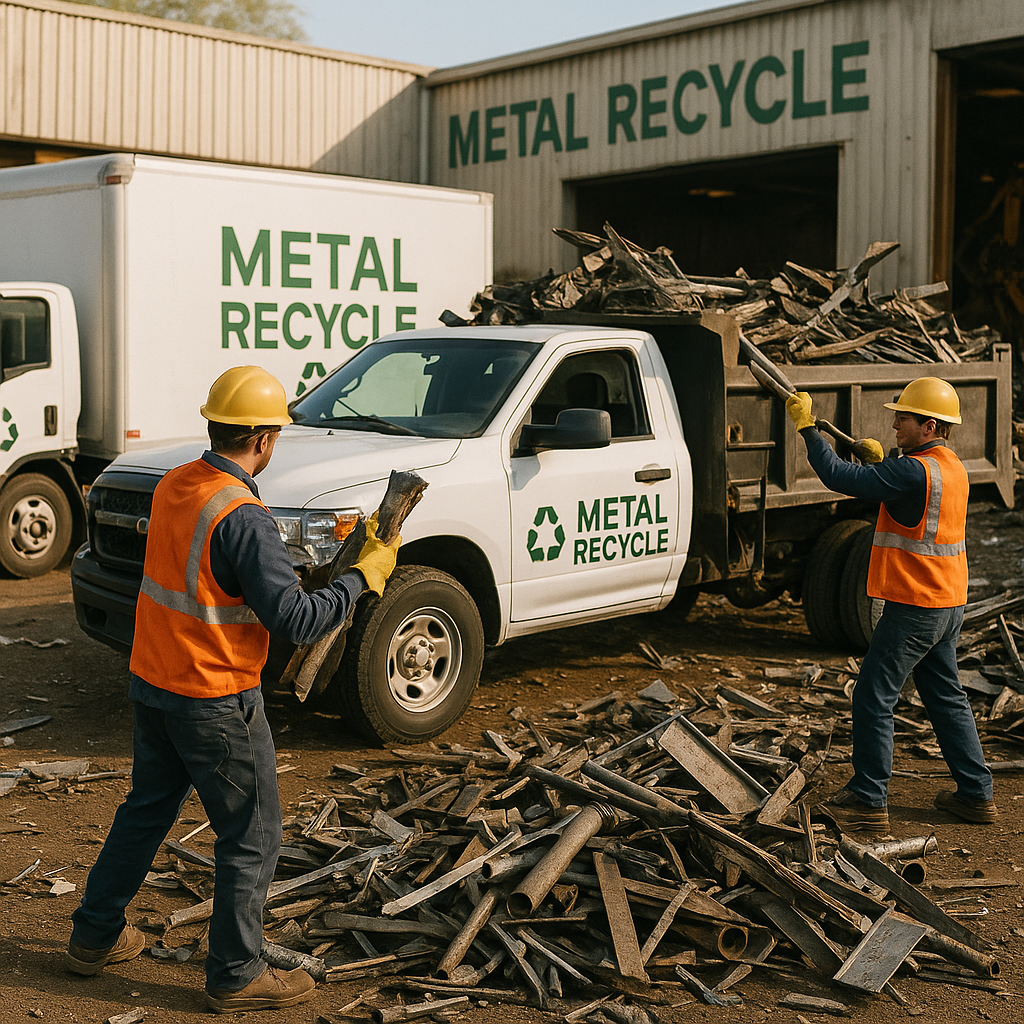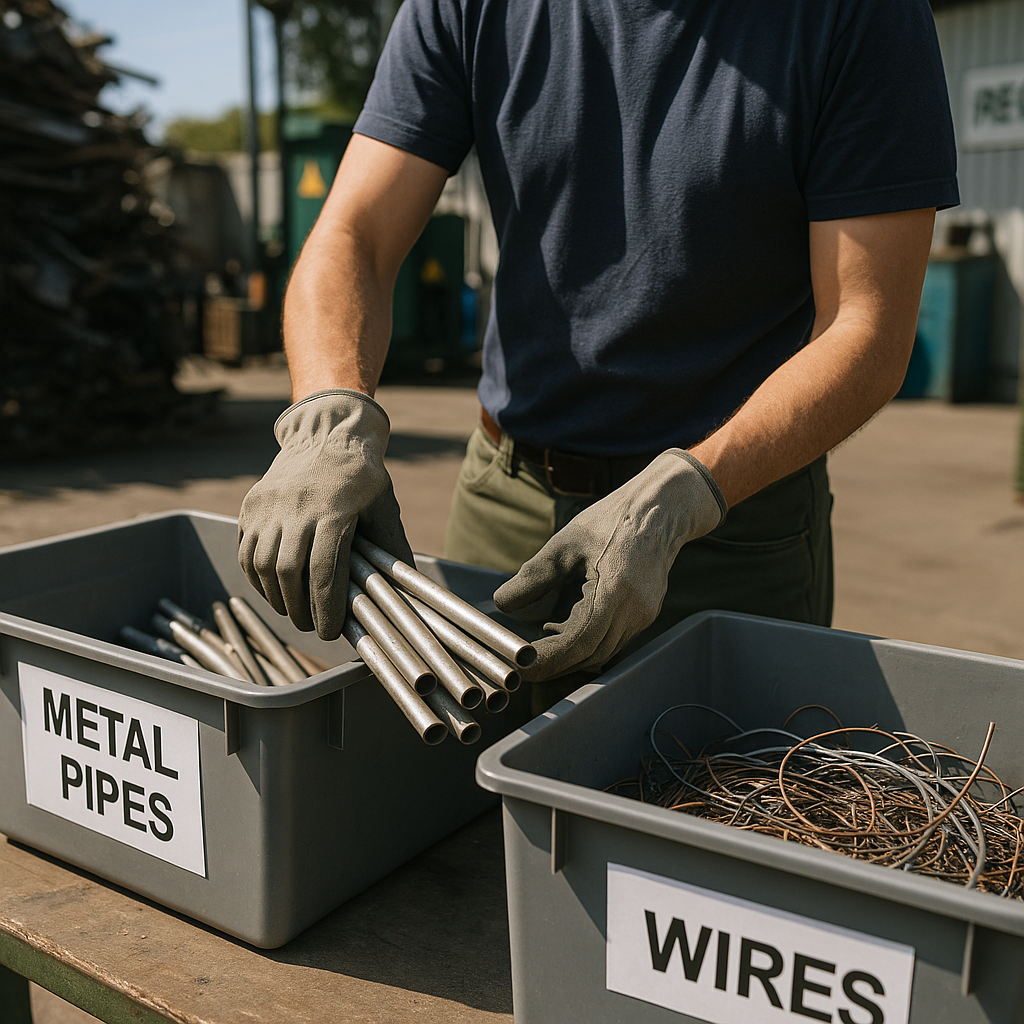5901 Botham Jean Blvd, Dallas, TX 75215
Metal Recycling: A Quick Overview for Beginners
September 17, 2025Did you know that recycling aluminum saves up to 95% of the energy needed to produce it from raw materials? This remarkable efficiency underscores the importance of metal recycling in conserving resources.
Metal recycling involves collecting, sorting, and processing scrap metals to manufacture new products, transforming potential waste into valuable resources. The process includes gathering end-of-life metal products, sorting them by type, shredding or melting them down, and using the reclaimed material to create new items.
The importance of metal recycling goes beyond simple waste reduction. Metals are ideal for a circular economy, as they can be recycled indefinitely without losing their properties or quality. This infinite recyclability means the steel in your car today could be part of a building framework tomorrow and a household appliance in the future.
What are the Most Valuable Metals to Recycle?

The recycling industry values certain metals more highly than others based on their scarcity, utility, and recyclability. Understanding which metals fetch the highest prices can help businesses and individuals maximize the economic benefits of their recycling efforts while contributing to resource conservation.
Copper stands at the top of the value chain among commonly recycled metals. This reddish metal commands premium prices at recycling facilities due to its excellent electrical conductivity and resistance to corrosion. Recycling copper uses up to 85% less energy than primary production, making it both economically and environmentally beneficial to recycle.
Aluminum is another highly valuable recyclable metal. Its lightweight properties and infinite recyclability make it a cornerstone of sustainable manufacturing. Recycling aluminum saves approximately 95% of the energy required to produce new aluminum from raw bauxite ore, leading to reduced carbon emissions and lower production costs.
Brass, an alloy of copper and zinc, ranks third among valuable scrap metals. Its distinctive golden appearance and durability make it commonly found in plumbing fixtures, musical instruments, and decorative items. Recycling brass conserves both copper and zinc resources while reducing mining impacts.
Ferrous vs. Non-Ferrous Metals
The recycling industry classifies metals into two main categories: ferrous and non-ferrous. This distinction significantly affects their value and recycling processes.
Non-ferrous metals do not contain iron and generally command higher prices in the recycling market. These include copper, aluminum, brass, lead, and zinc. Their value stems from their unique properties and relative scarcity. Non-ferrous metals do not rust and typically offer better conductivity than their ferrous counterparts.
Ferrous metals, which contain iron, include steel and cast iron. While they typically fetch lower prices per pound than non-ferrous metals, they make up for this in volume. The construction and automotive industries generate massive amounts of ferrous scrap, making steel the most recycled material by weight worldwide.
Top Recyclable Metals and Their Common Uses
- Copper – Electrical wiring, plumbing pipes, electronics, renewable energy systems
- Aluminum – Beverage cans, automobile parts, construction materials, packaging
- Brass – Plumbing fixtures, musical instruments, decorative items, ammunition casings
- Stainless Steel – Kitchen appliances, medical equipment, architectural applications
- Lead – Batteries, radiation shielding, roofing materials
- Zinc – Galvanized steel coating, die-casting, brass production
Steel, though lower in value per pound, remains crucial to the recycling ecosystem due to its abundance. It can be recycled repeatedly without degradation in quality, making it a perfect example of closed-loop recycling. Construction debris, automotive parts, and appliances provide steady streams of recyclable steel.
Stainless steel, a ferrous metal with added chromium and sometimes nickel, offers better corrosion resistance than standard steel. This specialized alloy commands higher prices than regular steel but still less than non-ferrous metals like copper and aluminum.
Market conditions influence scrap metal prices, with factors like global demand, energy costs, and transportation expenses all playing roles. Industries processing large volumes of metal should monitor these market fluctuations to optimize the timing of their recycling efforts.
For businesses generating significant metal waste, separating different types of metals before recycling can substantially increase their value. Contaminated or mixed metals typically receive lower prices than clean, sorted materials. This practice of proper segregation represents one of the simplest ways to improve the economics of metal recycling.
What are the Best Practices for Sorting Scrap Metal?

Sorting scrap metal properly maximizes its value and streamlines the recycling process. The difference between sorted and unsorted scrap can be significant—properly sorted metals can fetch up to 30-40% more than mixed materials. Here’s a comprehensive guide to sorting your scrap metal effectively.
Use the Magnet Test to Separate Ferrous from Non-Ferrous Metals
The magnet test is your first and most fundamental sorting method. This simple technique divides your materials into two main categories.
Ferrous metals contain iron and are magnetic. When you hold a strong magnet to these metals, it will stick firmly. Common ferrous metals include steel, cast iron, and wrought iron. These materials typically have lower value per pound but are still worth recycling.
Non-ferrous metals don’t contain iron and won’t attract a magnet. These include aluminum, copper, brass, bronze, and lead. Non-ferrous metals generally command higher prices at recycling centers, making proper identification crucial for maximizing returns.
Sort By Specific Metal Type
After separating ferrous from non-ferrous materials, further sort your scrap by specific metal types. This additional level of sorting can increase your returns by 15-20%.
For non-ferrous metals, create separate containers for aluminum, copper, brass, and other valuable metals. Aluminum is lightweight with a silvery appearance. Copper has a distinctive reddish-brown color. Brass displays a yellowish, gold-like appearance.
For ferrous metals, separate regular steel from stainless steel when possible. Stainless steel, while sometimes slightly magnetic, is more valuable than regular steel due to its corrosion resistance.
Remove Contaminants and Attachments
Clean, contamination-free metal always brings higher prices. Take time to prepare your scrap by removing non-metal components that reduce value.
Strip insulation from copper and aluminum wires. This simple step can increase their value by 30-50%. Remove plastic casings from electronics and rubber attachments from plumbing fixtures. Detach wooden handles from tools and fabric from appliances.
Wipe down greasy or oily metal parts, as excessive oil can be considered a contaminant. While removing paint is ideal, it’s often not practical for most scrappers.
Distinguish Between Clean and Dirty Metals
Clean metals are free from attachments or contaminants and command higher prices. These should be in their purest form without foreign materials like screws, bolts, or paint.
Dirty metals show signs of oxidation, rust, paint, or attachments. When possible, clean these metals before recycling. If attachments are made of the same metal type, the material can still be considered “clean.”
Use Proper Storage Methods
Store your sorted metals in separate, clearly labeled containers to prevent mixing and contamination. Sturdy bins work well for heavier metals like copper and brass. Lightweight bins or bags are suitable for aluminum.
Store valuable metals like copper in secure locations. Keep electronics in covered containers to protect them from moisture. For large quantities of steel or iron, outdoor storage may be acceptable if properly organized.
Transport to a Reputable Recycling Center
Research and choose a recycling center known for fair pricing and responsible practices. Contact them beforehand to understand their specific requirements and potential incentives for well-sorted scrap.
Consider timing your sales based on market conditions, as metal prices fluctuate with supply and demand. Some periods may see higher prices for certain metals due to increased industrial demand.
When possible, consolidate your scrap into larger loads to save on transportation costs. Building a relationship with your recycling center can lead to better service and potentially higher prices over time.
Conclusion: The Future of Metal Recycling
Metal recycling plays a crucial role in global sustainability efforts, offering significant benefits such as conserving natural resources and reducing greenhouse gas emissions. With technological advancements, innovations like AI-powered sorting systems and chemical recycling techniques are enhancing the industry’s efficiency. These developments enable the recovery of valuable materials that were once non-recyclable.
The future of metal recycling is promising as awareness increases and supportive policies bolster industry growth. Recycling aluminum saves 95% of the energy needed for production from virgin materials, while steel recycling reduces CO2 emissions by around 58%. These statistics highlight the significant environmental impact of effective metal recycling. For all your metal recycling needs, contact Okon Recycling at 214-717-4083.
